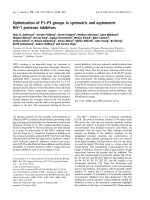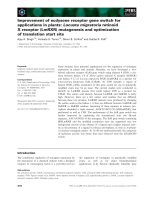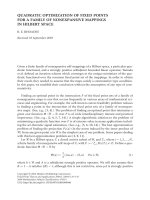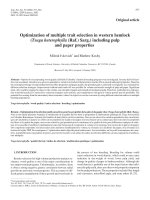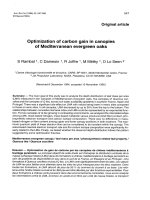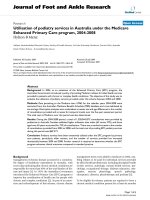Optimization of iot services deployment in cloud fog system
Bạn đang xem bản rút gọn của tài liệu. Xem và tải ngay bản đầy đủ của tài liệu tại đây (1.48 MB, 55 trang )
VIETNAM NATIONAL UNIVERSITY, HANOI
UNIVERSITY OF ENGINEERING AND TECHNOLOGY
DANG VAN DO
OPTIMIZATION OF IOT SERVICES DEPLOYMENT
IN CLOUD-FOG SYSTEM
MASTER THESIS
Major: Data Communication and Computer Networks
HA NOI - 2019
VIETNAM NATIONAL UNIVERSITY, HANOI
UNIVERSITY OF ENGINEERING AND TECHNOLOGY
Dang Van Do
OPTIMIZATION OF IOT SERVICES DEPLOYMENT
IN CLOUD-FOG SYSTEM
MASTER THESIS
Major: Data Communication and Computer Networks
Supervisor: Dr. Tran Truc Mai
Assoc.Prof. Nguyen Kim Khoa
HA NOI - 2019
Abstract
With the predicted explosion in the number of connected devices, sensors and
extremely large amount of data generated need to be analyzed, the current cloud
paradigms, which tend to me concentrate computing and storage resources in a
few large data centers, will inevitably lead to excessive network load, end-to-end
service latency, and overall power consumption. This leads to the creation of new
network architectures that extend computing and storage capabilities to the edge
of the network, close to end-users. Along with the new network architectures, it
enables a new breed of services and applications with tightly Quality of services.
The emerging problem is how to efficiently deploy the services to the system
that satisfies service resource requirements and QoS constraints while maximizing
resource utilization.
In this thesis, we investigate the problem of IoT services deployment in CloudFog system to provide IoT services with minimal resource usage cost. We formulate the problem using a Mixed-Integer Linear Programming model taking into
account the characteristics of computing and transmission resources in Cloud-Fog
system as well as the IoT services specific requirements. Our solution provides
a multi-layer mapping mechanism that efficiently deploys IoT services to the appropriate virtual network in physical infrastructure. Unfortunately, our proposed
model is unable to solve in polynomial time due to it is NP-hard. We propose
greedy-based algorithms for solving the problem which tries to solve each phase
of the deployment process sequentially. We illustrate the utility of our solutions
over a motivating example where we compare the efficiency of our solutions with
the existing solutions for a traffic monitoring service. The experimental results
show that our proposed solution outperforms compared to existing solutions in
terms of energy efficiency.
iii
Acknowledgements
I would like to express my sincere gratitude to Dr. Tran Truc Mai and Assoc. Prof Nguyen Kim Khoa, my supervisors, for providing continuous support to
my studies and research, for their patience, motivation, enthusiasm and immense
knowledge. Their guidance helped me all the time doing this research and writing
this thesis.
My sincere thanks also go to the Faculty of Information and Technology, University of Engineering and Technology, Vietnam National University for providing me all the necessary facilities to make this research project easier.
Finally, I would like to say thanks to my family, my friends who have always
believed, motivated and supported me throughout the past process to achieve today’s results.
iv
Declaration
I hereby declare that this thesis was entirely my own work and that any additional sources of information have been duly cited.
I certify that, to the best of my knowledge, my thesis does not infringe upon
anyone’s copyright nor violate any proprietary rights and that any ideas, techniques, quotations, or any other material from the work of other people included
in my thesis, published or otherwise, are fully acknowledged in accordance with
the standard referencing practices.
Furthermore, to the extent that I have included copyrighted material, I certify
that I have obtained written permission from the copyright owner(s) to include
such material(s) in my thesis and have included copies of such copyright clearances to my appendix.
I declare that this thesis has not been submitted for a higher degree to any other
University or Institution.
v
Table of Contents
Abstract
iii
Acknowledgements
iv
Declaration
v
Table of Contents
vii
Acronyms
viii
List of Figures
x
List of Tables
xi
1
Introduction
1
1.1
Motivation . . . . . . . . . . . . . . . . . . . . . . . . . . . . .
1
1.2
Problem statement . . . . . . . . . . . . . . . . . . . . . . . . .
4
1.3
Research questions . . . . . . . . . . . . . . . . . . . . . . . .
6
1.4
Objectives . . . . . . . . . . . . . . . . . . . . . . . . . . . . .
7
1.5
Outline . . . . . . . . . . . . . . . . . . . . . . . . . . . . . . .
8
2
Literature review
9
2.1
Fog computing and the Internet of Things . . . . . . . . . . . . .
9
2.1.1
Definition . . . . . . . . . . . . . . . . . . . . . . . . .
9
2.1.2
Reference Architecture . . . . . . . . . . . . . . . . . .
10
2.2
IoT services . . . . . . . . . . . . . . . . . . . . . . . . . . . .
14
2.3
Optimal services deployment problem . . . . . . . . . . . . . . .
16
vi
3
5
Algorithms . . . . . . . . . . . . . . . . . . . . . . . .
16
2.3.2
Comparison and discussion . . . . . . . . . . . . . . . .
20
Methodology
22
3.1
System model . . . . . . . . . . . . . . . . . . . . . . . . . . .
22
3.1.1
Network model . . . . . . . . . . . . . . . . . . . . . .
22
3.1.2
Service model . . . . . . . . . . . . . . . . . . . . . . .
23
3.1.3
Virtual layer model . . . . . . . . . . . . . . . . . . . .
24
The optimization of IoT services deployment in Cloud-Fog system
24
3.2.1
MILP formulation. . . . . . . . . . . . . . . . . . . . .
24
3.2.2
Deployment model. . . . . . . . . . . . . . . . . . . . .
32
3.2
4
2.3.1
Experiment results and discussion
36
4.1
Experiment results . . . . . . . . . . . . . . . . . . . . . . . . .
36
4.1.1
Simulation details . . . . . . . . . . . . . . . . . . . . .
36
4.1.2
Simulation scenarios . . . . . . . . . . . . . . . . . . .
38
Conclusion
42
vii
Acronyms
4G
Fourth Generation
CPU
Central Processing Unit
DC
Data Center
Gbps
Gigabit per second
IoT
Internet of Things
J/bit
Joule per bit
Mbps Megabit per second
MCF
Multi-commodity Flow
MILP Mixed Integer Linear Programming
MIPS Millions of Instructions Per Second
NP
Non-deterministic Polynomial-time
QoS
Quality of Service
TCP
Transmission Control Protocol
UDP
User Datagram Protocol
viii
VM
Virtual Machine
VNE
Virtual Network Embedding
VNF
Virtual Network Function
WSN
Wireless Sensor Network
ix
List of Figures
1.1
Three-layer Cloud-Fog system paradigm . . . . . . . . . . . . .
2
1.2
IoT services in Cloud-Fog system . . . . . . . . . . . . . . . . .
3
2.1
Fog computing reference architecture [1] . . . . . . . . . . . . .
12
3.1
Traffic monitoring service model. . . . . . . . . . . . . . . . . .
23
3.2
Services deployment problem . . . . . . . . . . . . . . . . . . .
26
4.1
Smart city infrastructure used in our simulations. . . . . . . . . .
37
4.2
Average power consumption of the traffic monitoring service for
different amounts of energy consumed by server nodes in idle state. 39
4.3
Average power consumption of the traffic monitoring service for
different edge node efficiencies. . . . . . . . . . . . . . . . . . .
x
40
List of Tables
2.1
Differences between cloud and fog computing . . . . . . . . . .
11
2.2
Comparison of characteristics of related work . . . . . . . . . . .
21
3.1
Notations . . . . . . . . . . . . . . . . . . . . . . . . . . . . .
29
4.1
Cloud-Fog system resources . . . . . . . . . . . . . . . . . . . .
37
xi
Chapter 1
Introduction
1.1
Motivation
Along with the development of connected devices and smart environments, the
Internet of Things (IoT) has been receiving attention for years that the most obvious evidence is the growth in the number of devices over time. It enables a new
breed of services and applications expected to analyze and augment captured data
from IoT devices to create meaningful information for the end-users. Due to the
limitations of computing and storage on devices, cloud computing is considered
as a promising computing paradigm, which can provide elastic resources to the
IoT services and applications. However, for those applications with low latency,
location-awareness, mobility support requirements, the current centralized cloud
paradigm, which tends to concentrate computing and storage resources in a few
large data centers, will be no longer suitable. Recently, Cisco has introduced Fog
computing as a new paradigm which takes advantage of the extensive resources in
the cloud while being able to expand computing power to the edge of the network,
close to end-users [2, 3].
Fig. 1.1 illustrates the architecture of a Cloud-Fog system with three hierarchical layers where VNFs are deployed to implement service functions. At the edgemost of the network is the device layer which contains numerous sensory nodes.
They can be widely distributed at various public infrastructures to monitor their
condition changes over time. Each node either collects data (i.e., video, temperature, noise) or performs a certain function (i.e., sprinkle, smart light). Data gener1
Figure 1.1: Three-layer Cloud-Fog system paradigm
ated by IoT devices can be sent to and processed by the VNFs deployed at the fog
nodes nearby the data sources. The fog nodes can be micro clouds, access network
devices or even user devices, which located in a wide-spread geographical area,
together they form the fog layer that lies between the device layer and the cloud
layer. Each fog node is connected to and responsible for a group of IoT devices,
performing data analysis in a timely manner. Thanks to the virtualization technology, the fog nodes with heterogeneous resources can provide the ability to implement IoT service functions, providing the ability to reduce network load as well
as ensure service QoS constraints including latency and location-awareness. On
top of the architecture is cloud layer consists of a number of powerful servers allocated in a few data centers. The cloud layer is considered as an unlimited resource
pool providing an ability to host VNFs that process computational-intensive tasks,
store a massive amount of data.
The IoT services take an important part in the Cloud-Fog system paradigm. It
takes the form of the service layer above the shared physical infrastructure layer
as illustrated in Fig. 1.2. A key aspect of increasing service performance and
energy efficiency is the actual deployment of services functions. Deployment
2
decisions need to address the resource requirements of the services, make sure
that the services meet its QoS constraints, and reduce the overall running cost of
the system. The allocation of resources in a non-optimal way will result in both
low-performance of services and an increase in the number of physical servers to
use while some of these servers have a very low usage rate.
Figure 1.2: IoT services in Cloud-Fog system
While the basic ideas and theoretical foundations of fog computing have been
established, the optimal deployment of IoT services onto the Cloud-Fog environment is still facing many challenges. While IoT service functions prefer to be
hosted at the nearby fog nodes instead of cloud to obtain the low latency and location tracking, a fog node can only host a limited number of the service functions
due to its resource capabilities. Unlike fog nodes, the cloud is considered as a
powerful and unlimited resources pool to deploy IoT service functions. However,
the cloud is far from IoT device networks, deploying IoT service functions to
cloud may cause the increasing of network load and service latency. The network
operator has, therefore, to optimize resource utilization while satisfying strict latency constraints when deploying IoT applications. While the prior works focus
on application placement problem which tries to map application functions into
3
physical resources, we go a further step in this work by taking into account a
multi-layer mapping where service functions are deployed into virtual resources
before being mapping to physical resources. The Cloud-Fog system is composed
of services, virtual resources, and physical resources. The virtual layer contains
a network of virtual machines that host IoT service functions and be deployed to
the physical layer. The virtual machine has a limited number of flavors that define
a number of parameters in which the virtual machine belongs to. We formulate
an optimization problem that performs multi-layer mapping that reduces energy
costs and increases resource utilization in both fog and cloud. Unfortunately, our
optimization model belongs to the NP-hard form that challenges any solver to find
an optimal solution in polynomial time. We propose a greedy-based algorithm to
obtain a near-optimal solution for the problem within an acceptable period of time.
In this thesis, we propose a solution for finding optimal IoT services deployment in the Cloud-Fog system, where the goal is to find the appropriate virtual
machines for each service function and then place the network of the virtual machines onto Cloud-Fog system infrastructure that minimizes the overall energy
consumption. Our contributions can be summarized as follows:
• We formulate the problem of the combination of IoT services deployment and
virtual machine consolidation in the Cloud-Fog system as a mixed-integer linear program with three layers in the Cloud-Fog system including the service
layer, virtual layer, and physical infrastructure layer.
• We propose a greedy-based solution for solving the problem of optimized
deployment of IoT services in the Cloud-Fog system in which tries to solve
each phase of the deployment process sequentially.
1.2
Problem statement
The Cloud-fog system is considered to be an efficient solution for providing
resources to handle newly emerging IoT services with tightly QoS constraints.
However, while the basic ideas and theoretical foundations of fog computing have
been established [1, 2], deploying IoT services onto a Cloud-Fog system is still
facing many challenges. Offloading IoT services to the cloud may result in an
4
additional network traffic load, increasing unnecessary costs while failing to meet
the latency constraints of delay-sensitive services. On the contrary, the computingintensive functions of IoT services can not be deployed to the devices due to its
limitations on computing power and battery life. Furthermore, manual deployment of complex IoT services onto the Cloud-Fog system can be complex, timeconsuming and error-prone. Therefore, the resource provider has to offer a service
that ensures optimal automatic deployment of IoT services.
One of the major issues in implementing the service is solving the problem of
optimal deployment of services functions into physical resources. The problem
contains selecting of appropriate virtual machines for service functions and then
assigning existing resources to the network of these virtual machines according to
specific constraints.
Typically, an IoT service has its own resource requirements and QoS constraints. The resource requirements of a service often include computing and
transmission capacity which referred to a collection of processor, memory, storage
and bandwidth capacity that guarantees the properly running of the service. Latency is often referred to when considering the quality requirements of a service.
The optimal deployment of IoT services is known as a highly complex process
that requires to minimize the mapping costs, ensures the deployed services can
meet its requirements as well as maximize the resource utilization.
Overall, the following challenges are what we have to face when building the
service that optimizes the deployment of IoT services in Cloud-Fog system:
• Cost - energy consumption
Allocating more resources than required when virtualizing services will incur
unnecessary costs, whereas allocating insufficient resources will lead to the
poor performance operation of the services. Besides, Cloud-Fog system is a
heterogeneity multi-layered system in which each resource has its own processing, storage, and transmission capabilities as well as energy efficiency,
the deployment strategy will determine the operating cost of the services.
Our proposed solution has to take into account the capabilities and energy
efficiency of computing and transmission resources to minimize the energy
consumption of the system.
5
• QoS constraints
Cost minimization may result in the low-performance of the services. The
challenge here is to provide the IoT services with required QoS constraints
with the optimal energy consumption. For example, the cloud may have powerful resources with high energy efficiency, however, it is far away from enduser devices while the fog nodes close to end-user have a limitation on computing power. A good deployment strategy is to deploy computing-intensive
functions onto the cloud and the delay-intensive functions onto nearby fog
nodes.
Therefore, our solution has to come with a strategy that ensures QoS for IoT
services by taking the location and link delay into consideration.
• Resource utilization
The allocation of resources in a non-optimal way will result in an increase
in the number of physical servers to use while some of these servers have a
very low usage rate. These servers contribute significantly to rising operating costs, low energy efficiency. Virtual machines consolidation promises to
be a significant emerging solution to alleviate these problems. Basically, the
Cloud-Fog system is built up of numerous physical servers and each of these
servers can run multiple virtual machines. Theoretically, virtual machine consolidation concentrates target VMs into as small a number of running physical servers as possible according to their resource demands. Underutilized
servers should be switched to the sleep mode or switched off so that they consume no power [4]. A consolidation strategy has to be taken into account to
maximize resource utilization.
1.3
Research questions
To address the aforementioned challenges, the following key research questions
have been raised:
• RQ1: How should we model IoT services to optimally virtualize each service
function in Cloud-Fog system?
The proposed system model must demonstrate characteristics of IoT services
6
including resource requirements, latency, and location constraints as well as
taking into account the heterogeneous, distributed manner of the Cloud-Fog
system.
• RQ2: How the problem of optimal deployment of IoT services in Cloud-Fog
system should be formulated?
The proposed formulation for the problem will use the proposed system model
and define a set of mathematical expressions to represent the system’s constraints.
• RQ3: How can we optimally deploy IoT services onto the Cloud-Fog system
with given resource constraints in order to meet service requirements and
minimize the total energy consumption of the system?
The purpose is to design an algorithm that efficiently allocates compute and
networking resources to IoT services at minimal cost and maximal resource
utilization while meeting service requirements.
1.4
Objectives
Our main objective, in this thesis, is to propose a solution that solves the optimal deployment of IoT services in the Cloud-Fog system. It is divided into
sub-objectives as follows:
• O1: Building a mathematical model that represents the IoT services and
Cloud-Fog system.
• O2: Building an optimization model for minimizing the total energy consumption of the system while maintaining the resource requirements and QoS
constraints of IoT services.
• O3: Design an algorithm that optimizes the IoT services deployment onto
Cloud-Fog system running in near real-time. The algorithm will collect information about services requirements and substrate resources at a centralized
network controller, find the optimal deployment and disseminating the solution to all network nodes.
7
• O4: Carrying our simulations to validate the outperformance of our solution
compared to existing solutions.
1.5
Outline
This thesis is divided into five chapters organized as follows:
• The first chapter is a general introduction. We first present the general context
and motivation of this research. Then, the problem statement, the research
questions and the objectives to be achieved are presented.
• The second chapter discusses the technical background and the related work.
In this chapter, we provide background knowledge needed to understand subsequent materials in the next chapters. Then, we present a review of the prior
works that have dealt with the services deployment problem and, based on
their findings, a synthesis was made to compare the different existing approaches, their limitations and highlight the contributions of this thesis.
• The third chapter presents the methodology. According to the objectives of
this thesis, we first present the system modeling and then propose a formulation for optimization of IoT services deployment in the Cloud-Fog system
problem. Finally, we design an algorithm to efficiently deploy IoT services
onto Cloud-Fog system.
• The fourth shows the experiment results of our proposed solution.
• I conclude my work in chapter fifth and discuss some possible future works
on this problem.
8
Chapter 2
Literature review
2.1
Fog computing and the Internet of Things
This section provides background knowledge of this thesis, including fog computing, IoT and the services deployment problem.
2.1.1
Definition
Fog computing, a concept introduced by CISCO in 2012, is considered as an
extension of the traditional cloud computing paradigm from the core to the edge
of the network. It supports virtualization that enables computing at the edge of
the network to provide computation, storage, and network services closer to IoT
and/or end-user devices where data is being generated [2]. The implementations
of fog computing can reside in multiple layers of a network’s topology and the
cloud takes an important part in the architecture.
Characteristics of fog computing:
• Low latency and location-awareness: The fog contains of multiple computing
nodes located at the edge of the network close to IoT and/or end-user devices
which means that Fog Computing supports endpoints with the finest services
at the edge of the network.
• Widespread geographical distribution: The fog nodes typically are distributed
in a large geographic area. In contrast to traditional centralized cloud, the services and applications targeted by Fog Computing demand widely distributed
9
deployments.
• A large number of network nodes: as a consequence of the wide geo-distribution,
as evidenced in sensor networks in general, and the Smart Grid in particular
• Heterogeneity: Fog nodes come in different form factors, and will be deployed in a wide variety of environments.
• Support for mobility: It is essential for many Fog applications to communicate
directly with mobile devices, and therefore support mobility techniques, such
as the LISP protocol1 , that decouple host identity from location identity, and
require a distributed directory system.
• Predominant role of wireless access
• Real-time interactions: Important Fog applications involve real-time interactions rather than batch processing.
• Interoperability and federation: Seamless support of certain services (streaming is a good example) requires the cooperation of different providers. Hence,
Fog components must be able to interoperate, and services must be federated
across domains.
Table 2.1 delineates the differences between Cloud and Fog Computing [5].
2.1.2
Reference Architecture
The Fig. 2.1 presents a reference architecture for fog computing proposed
in [1]. The bottommost layer contains the end devices (sensors), as well as enduser devices, edge devices and gateways. This layer also includes applications
that can be installed in the end devices to enhance their functionality. The network layer take the responsibble for communication between devices in device
layer and the between the device layer and the cloud. The next layer contains
cloud resources and services that provide computing power to process IoT functions which offloaded to the cloud. On top of the cloud layer lays the resource
management services that manage the whole infrastructure and enable quality of
1
/>
10
Table 2.1: Differences between cloud and fog computing
Requirements
Cloud computing
Fog computing
Latency time
High
Low
Delay Jitter
High
Very low
Access
Fixed and wireless
Mainly wireless
Service location
Within the internet
At the edge of the network
No. of server nodes
Few
Very large
Distance (client–server)
Multiple hops
Only one hop
Security
Undefined
Can be defined
Location awareness
No
Yes
Support for mobility
Limited
Supported
Geo distribution
Centralised
Distributed
Availability
99.99%
Highly
volatile/redundant
11
Figure 2.1: Fog computing reference architecture [1]
12
service to fog computing applications. Finally, the topmost layer the IoT services
that leverage fog computing to deliver innovative and intelligent applications to
end users [1].
Looking inside the Software-Defined Resource Management layer, it implements many services to optimize the use of cloud and fog resources on behalf of
the applications. The goal of the services is to reduce the cost of using the system
while maintaining the performance of IoT services by dynamically using cloud
and fog resources.
• Flow and task placement: this component keeps track of the state of available
cloud, Fog and network resources (information provided by the Monitoring
service) to identify the best candidates to hold incoming tasks and flows for
execution. This component communicates with the Resource Provisioning
service to indicate the current number of flows and tasks, which may trigger
new rounds of allocations if deemed too high.
• Knowledge Base: This component stores historical information about application demand and resource demands that can be leveraged by other services
to support their decision-making process.
• Performance Prediction: This service utilizes information of the Knowledge
Base service to estimate the performance of available cloud resources. This
information is used by the Resource Provisioning service to decide the amount
of resources to be provisioned. In times where there is a large number of tasks
and flow in use or when performance is not satisfactory.
• Raw Data Management: This service has direct access to the data sources and
provides views from the data for other services. Sometimes, these views can
be obtained by simple querying (e.g, SQL, or NoSQL REST APIs), whereas
other times more complex processing may be required (e.g, MapReduce).
Nevertheless, the particular method for generation of the view is abstracted
away from other services.
• Monitoring. This service keeps track of the performance and status of applications and services and supplies this information to other services as required.
13
• Profiling. This service builds resource and applications profiles based on information obtained from the Knowledge Base and Monitoring services.
• Resource Provisioning: This service is responsible for acquiring cloud fog
and network resources for hosting the applications. This allocation is dynamic, as requirements of applications, as well as number of hosted applications, changes over time. Decision on the number of resources is made
with use of information provided by other services (such as Profiling, Performance Prediction, and Monitoring) and user requirements on latency as well
as credentials managed by the Security service. For example, the component
pushes service functions with low latency requirements to edge of network as
soon as free resources are available.
• Security: This service supplies authentication, authorization, and cryptography as required by services and applications.
Notice that all the elements and services described are referenced only. The actual
fog stacks and applications can be built without be use of all the elements, or can
be built with other elements not listed in Fig. 2.1. In this thesis, we focus on the
Resource Provisioning service to provide an optimal deployment stategy for IoT
services in Cloud-Fog system.
2.2
IoT services
Potentialities offered by the IoT make possible the development of a huge number of applications, of which only a very small part is currently available to our
society. Many are the domains and the environments in which new applications
would likely improve the quality of our lives: at home, while travelling, when
sick, at work, when jogging and at the gym, just to cite a few. These environments
are now equipped with objects with only primitive intelligence, most of times
without any communication capabilities. Giving these objects the possibility to
communicate with each other and to elaborate the information perceived from the
surroundings imply having different environments where a very wide range of
applications can be deployed [6].
14

